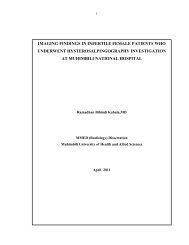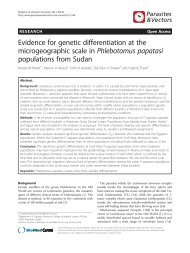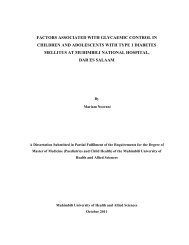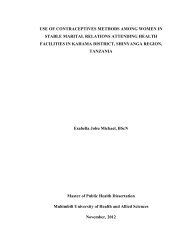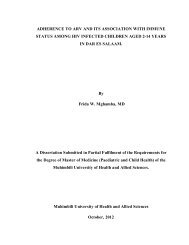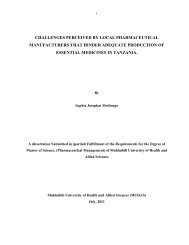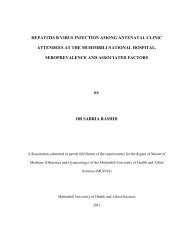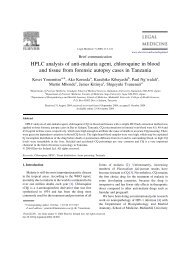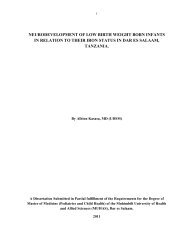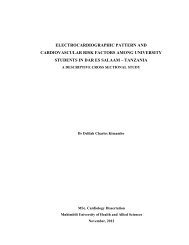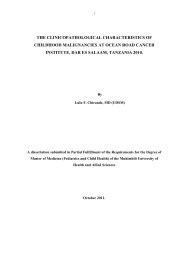MUNISI DISSERTATION REPORT FINAL[1].pdf - muhas
MUNISI DISSERTATION REPORT FINAL[1].pdf - muhas
MUNISI DISSERTATION REPORT FINAL[1].pdf - muhas
Create successful ePaper yourself
Turn your PDF publications into a flip-book with our unique Google optimized e-Paper software.
38<br />
that led to the sustained low prevalence of STH infections in school children as it has been<br />
reported that without environmental or behavioral changes the prevalence is likely to return to<br />
pre-treatment level if treatment is stopped (Olsen, 2003). All visited schools had pit latrines<br />
and shoe wearing has also become a tradition to most of the children, as on visual examination<br />
majority of the school children wore shoes, and for a few who did not have shoes had sandals<br />
(commonly known as yeboyebo) (Personal observation). This could partly explain for the<br />
observed low prevalence of STH in school children.<br />
The five children who were positive for the soil-transmitted helminths were all found to be<br />
from the middle plateau zone, four of them from one school and another one from another<br />
school. The localization of STH infections in the middle plateau zone relative to the other<br />
zones could probably be because of some behavioral and environmental factors that favor<br />
transmission of STH in this Zone. This observation is inline with the known fact that there is<br />
considerable geographical variation in the occurrence of helminths infections in East Africa,<br />
and that geographically targeted control programmes are required to maximize the costeffectiveness<br />
of chemotherapy (Brooker et al, 2009).<br />
In this study, of the STH infected school children, 3 had light intensity of infection with either<br />
hookworm or/and Ascaris lumbricoides and two hade moderate intensity of STH infection.<br />
The absence of heavy intensity of infection and the relatively higher prevalence of light<br />
intensity of infection could be the result of the mass chemotherapy which was done in 2008,<br />
the ongoing treatment of under five years children twice a year during the and probably some<br />
other behavioral and environmental factors that discourages transmission of STH among<br />
school children in the district.<br />
In this study, stunting (HAZ ≤ -2) was observed in 42.3% of the study participants. 11.1% of<br />
the study population was severely stunted. These results are almost similar to what has been<br />
reported by a study done in school going adolescents in India, where they reported an overall


![MUNISI DISSERTATION REPORT FINAL[1].pdf - muhas](https://img.yumpu.com/30272764/50/500x640/munisi-dissertation-report-final1pdf-muhas.jpg)
